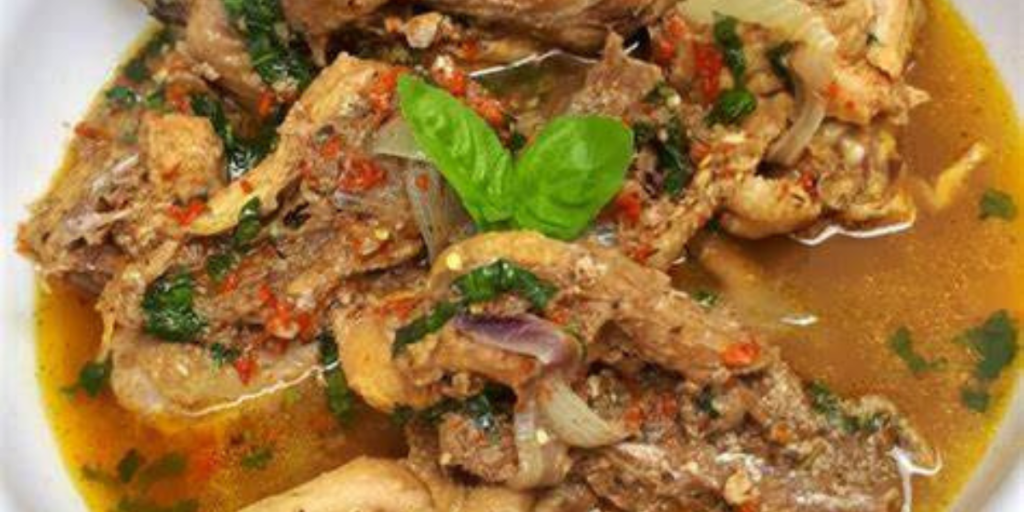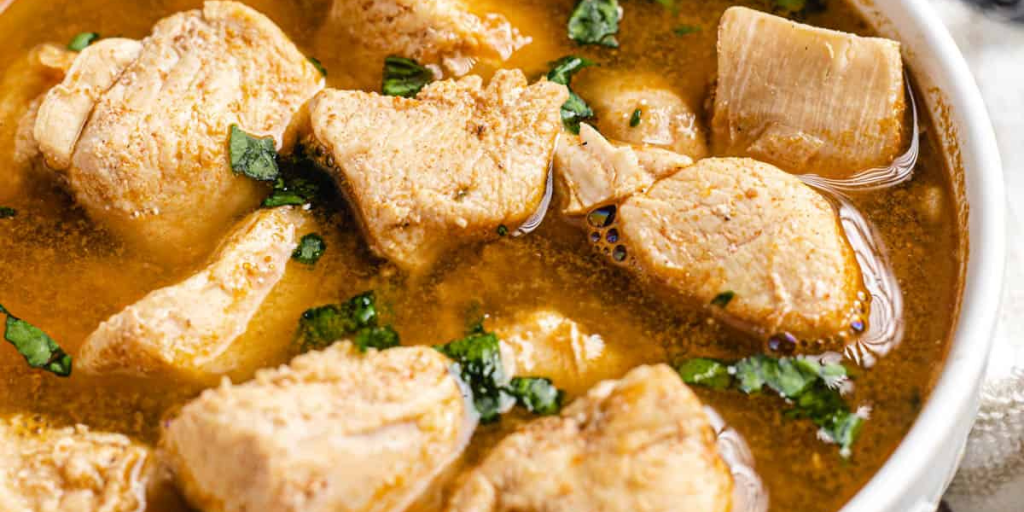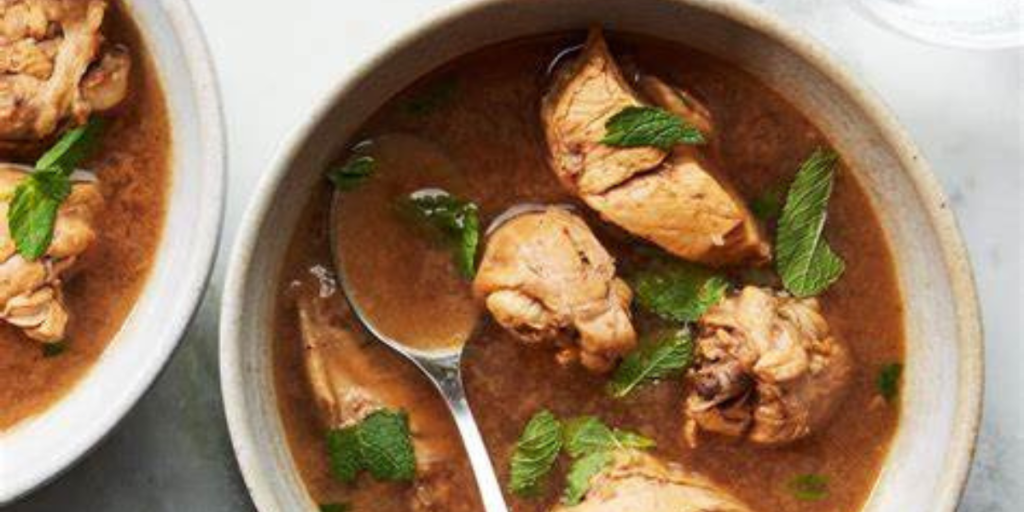Table of Contents
Chicken Pepper Soup is more than just a dish in Nigerian culture it’s a comforting, spicy, and aromatic soup that brings warmth to any occasion. Whether served as a starter at gatherings or as a hearty meal on a cold evening, this soup has its place in many homes across Nigeria. It holds a revered position among Nigeria’s popular meals and is often cherished for its medicinal qualities, especially in easing cold symptoms due to its peppery heat and the assortment of herbs and spices used in its preparation.
This dish is versatile and can be tailored to individual preferences. Some enjoy it with fewer spices, while others love it with an intense heat that clears the sinuses and invigorates the senses. Chicken Pepper Soup is traditionally made with chicken, aromatic spices, and herbs like uziza seeds, alligator pepper, and calabash nutmeg. While the ingredients may vary slightly based on the region and personal taste, the essence of the dish remains the same.
In this comprehensive guide, we’ll explore how to cook Chicken Pepper Soup Nigerian style, with a detailed look at the ingredients, preparation techniques, health benefits, and ways to customize the dish to suit your preferences.
The Origins of Chicken Pepper Soup in Nigerian Cuisine

Pepper soup in general is a fundamental part of Nigerian cuisine. It is not limited to chicken—variations include goat meat, fish, catfish (popularly known as “point and kill”), and even offal. However, chicken remains one of the most common and beloved versions of this dish. Historically, pepper soup has been a communal dish, served at parties, family gatherings, and even funerals. It’s often one of the first dishes brought out in social settings, symbolizing hospitality and warmth.
The heat from the pepper and the richness of the broth make it a dish that is both flavorful and deeply satisfying. It’s the Nigerian equivalent of comfort food, offering nourishment and a sense of well-being. In addition to its flavor, the medicinal qualities of pepper soup make it a go-to dish when someone is feeling under the weather. The combination of pepper, ginger, garlic, and local spices is believed to boost immunity and help fight off colds and flu.
Ingredients and Their Importance
The beauty of Chicken Pepper Soup lies in the simplicity of its ingredients, yet each component adds a layer of complexity to the final dish. Let’s break down the ingredients and their importance.
1. Chicken
Chicken is the star of the show, and the type of chicken you use can make a significant difference in the outcome of your soup. In Nigeria, local chicken, also known as “old layer” or free-range chicken, is often preferred for its rich flavor. These chickens are typically leaner and tougher than the broiler chickens commonly found in Western supermarkets, which means they need to be cooked longer to become tender.
The advantage of using local chicken is the depth of flavor it adds to the soup. Because these chickens are free-range and not as fatty, they produce a clearer, less oily broth. However, if local chicken is not available, broiler chicken or organic chicken can be used as a substitute. The key is to adjust the cooking time accordingly—local chicken takes longer to cook, while broiler chicken will cook faster and may not require as much simmering.
2. Uziza Seeds
Uziza seeds, also known as West African black pepper, are small, pungent seeds that add a sharp, peppery flavor to the soup. They have a slightly bitter undertone, which helps to balance the richness of the chicken broth. In addition to their flavor, uziza seeds are known for their medicinal properties—they aid digestion and are often used in traditional medicine to treat stomach issues.
3. Calabash Nutmeg
Calabash nutmeg, also called African nutmeg or Ehuru, is a spice that is commonly used in pepper soup. It has a warm, nutty flavor that complements the heat from the peppers. Ground calabash nutmeg is added to the soup during the cooking process to enhance its aroma and depth of flavor. This spice is often overlooked, but it plays a crucial role in giving Chicken Pepper Soup its unique taste.
4. Alligator Pepper
Alligator pepper is a fiery spice that comes from the seeds of a plant related to ginger. It is commonly used in Nigerian cuisine to add heat and flavor to soups and stews. In Chicken Pepper Soup, alligator pepper is used in combination with Scotch bonnet peppers to provide the characteristic spiciness of the dish. Alligator pepper is also believed to have medicinal properties, including aiding digestion and boosting the immune system.
5. Scotch Bonnet Peppers
No pepper soup is complete without the heat, and Scotch bonnet peppers provide just that. These fiery peppers are known for their intense heat and fruity flavor. They are used in moderation, depending on your tolerance for spice. While the heat is essential to the dish, the fruity notes of the Scotch bonnet also add complexity to the soup.
How To Make Chicken Pepper Soup Better in 2024
6. Ginger and Garlic
Ginger and garlic are essential aromatics in Chicken Pepper Soup. They add a sharp, pungent flavor that complements the spices and helps to cut through the richness of the chicken. In addition to their flavor, ginger and garlic have numerous health benefits. Ginger is known for its anti-inflammatory properties and can help soothe the digestive system, while garlic is believed to boost the immune system and lower cholesterol.
7. Stock Cubes
In many Nigerian homes, stock cubes such as Maggi or Knorr are used to enhance the flavor of the soup. While some purists may prefer to use homemade chicken broth, stock cubes provide a quick and convenient way to add depth and umami to the soup. Be careful not to overuse them, as they can make the soup too salty.
8. Scent Leaves or Basil
Scent leaves, also known as Nigerian basil, are often added to Chicken Pepper Soup to provide a fresh, herbaceous note. If scent leaves are not available, regular basil or even parsley can be used as a substitute. The addition of herbs towards the end of the cooking process helps to brighten the flavor of the soup and add a layer of complexity.
9. Water
Water is the base of the soup and helps to extract the flavors from the chicken and spices. The amount of water used will depend on how thick or light you want your soup to be. For a lighter, more brothy soup, use more water; for a thicker, heartier soup, use less.
Preparation Steps: Step-by-Step Guide

Cooking Chicken Pepper Soup may seem simple, but attention to detail is crucial to achieve the perfect balance of flavors. Here’s a step-by-step guide to preparing the soup:
Step 1: Prepare the Chicken
Start by cleaning your chicken thoroughly. If you’re using local chicken, you may need to spend a bit more time cleaning and cutting it into pieces, as it tends to be tougher than broiler chicken. Once cleaned, cut the chicken into bite-sized pieces.
Some people prefer to marinate the chicken for a few hours before cooking to allow the flavors to penetrate the meat. A simple marinade of ginger, garlic, and stock cubes will do the trick. This step is optional but highly recommended if you’re using broiler chicken, as it helps to enhance the flavor.
Step 2: Prepare the Spices
Next, prepare the spices. If you’re using whole spices such as uziza seeds and alligator pepper, it’s important to toast them first to release their oils and intensify their flavor. Toast the spices in a dry pan for a few minutes until fragrant, then grind them using a spice grinder or mortar and pestle.
For the garlic and ginger, you can either grate or blend them into a paste. This will ensure that their flavors are evenly distributed throughout the soup.
Step 3: Cook the Chicken
Place the chicken in a large pot and add enough water to cover it. Add the ginger, garlic, and stock cubes. Bring the water to a boil, then reduce the heat to a simmer. Allow the chicken to cook slowly, so it absorbs the flavors of the spices and becomes tender. If you’re using local chicken, this process can take up to an hour or more, while broiler chicken may cook in 30-40 minutes.
Step 4: Add the Spices and Peppers
Once the chicken is almost cooked, it’s time to add the ground spices and Scotch bonnet peppers. Be cautious with the peppers—Scotch bonnet can be incredibly hot, so start with a small amount and add more as needed. If you’re unsure about the heat level, you can remove the seeds from the peppers before adding them to the soup.
Step 5: Simmer and Adjust Seasoning
Allow the soup to simmer for another 15-20 minutes to allow the flavors to meld. Taste the soup and adjust the seasoning as necessary. If it’s too spicy, you can dilute the soup with more water or add a little sugar to balance the heat.
Step 6: Add Fresh Herbs
Finally, add the scent leaves or basil and let them simmer for just a few minutes before serving. The fresh herbs will add a burst of flavor and brighten the soup. If you don’t have access to scent leaves, regular basil or parsley will work as well.
How To Make Jollof Rice and Chicken Best Of 2024
Cooking Techniques
There are several methods you can use to cook Chicken Pepper Soup, depending on the tools you have available and how much time you want to spend.
Traditional Method (Stovetop)
The most common way to prepare Chicken Pepper Soup is on the stovetop. This method allows for slow, gentle cooking, which is ideal for developing the flavors of the soup. Using a large pot, simmer the chicken, spices, and water for about an hour (or more for local chicken) until the chicken is tender and the broth is flavorful.
Pressure Cooker Method
If you’re short on time or using tough local chicken, a pressure cooker can significantly speed up the cooking process. Pressure cookers trap steam inside, raising the cooking temperature and allowing food to cook faster while retaining more flavor. To cook Chicken Pepper Soup using a pressure cooker, follow the same preparation steps as the stovetop method, but reduce the cooking time. Local chicken may only take 30 minutes, and broiler chicken can be ready in as little as 15 minutes.
Once the chicken is tender, you can release the steam from the pressure cooker, add the spices and peppers, and simmer for a few more minutes to allow the flavors to meld. This method is particularly useful if you want to prepare a hearty, flavorful soup in a fraction of the time.
Slow Cooker Method
For those who prefer to let their food cook slowly over a longer period of time, a slow cooker is an excellent option. The advantage of using a slow cooker is that it allows the flavors to develop fully over several hours, resulting in a rich, deeply flavored soup.
To use a slow cooker, follow the same steps for preparing the chicken and spices, then transfer everything to the slow cooker. Set it to low and cook for 4-6 hours, depending on the type of chicken you’re using. Local chicken may take longer to become tender, so plan accordingly. As with the stovetop method, add the fresh herbs at the end of the cooking process to preserve their flavor.
Customizing Chicken Pepper Soup: Adding Your Twist

One of the great things about Chicken Pepper Soup is its versatility. While the traditional Nigerian recipe calls for a specific set of ingredients, you can customize the soup to suit your tastes or incorporate other ingredients to make it your own. Here are some ideas for personalizing your Chicken Pepper Soup:
1. Vary the Protein
Although chicken is the star of this dish, you can experiment with other proteins if you’d like to switch things up. Goat meat, catfish, and even shrimp are excellent alternatives that still pair well with the traditional spices. If you’re feeling adventurous, you can even mix different proteins together to create a more complex flavor profile. For example, combining chicken and goat meat can create a more robust dish with varying textures.
2. Play with the Heat
Scotch bonnet peppers are known for their intense heat, but if you’re someone who loves an extra kick, feel free to add more peppers or use a hotter variety. Alternatively, if you’re sensitive to spice, you can tone down the heat by using milder peppers or removing the seeds from the Scotch bonnets before adding them to the soup.
For an even more subtle peppery flavor, you can add bell peppers or sweet peppers to the soup. They provide a different layer of sweetness and won’t overpower the dish with heat.
3. Add Vegetables
While traditional Chicken Pepper Soup doesn’t typically include vegetables, there’s no rule against adding them. Carrots, potatoes, yams, and plantains can all be added to the soup to make it heartier and more filling. These vegetables soak up the flavors of the broth and provide a satisfying contrast to the heat of the peppers. Yams and plantains, in particular, add a starchy element that pairs beautifully with the spicy broth.
4. Thicken the Broth
For a more substantial, stew-like consistency, you can thicken the broth by adding a starchy element. Ground crayfish, for instance, is a popular addition in some regions of Nigeria. Crayfish adds both flavor and thickness to the soup. Another option is to blend a few of the boiled potatoes or yams directly into the soup. This technique will thicken the broth while also adding richness and depth to the flavor.
5. Use Different Herbs
Scent leaves are a staple in Nigerian cooking, but if you’re unable to find them, there are several other herbs that can provide a similar freshness. Basil, cilantro, or even mint can add a new dimension to the soup. Fresh parsley or thyme can also be used to add an earthy note to the broth. Be sure to add fresh herbs towards the end of the cooking process so that their flavors remain bright and vibrant.
6. Add Citrus
A squeeze of lime or lemon juice can add a zesty kick to Chicken Pepper Soup. The acidity from the citrus helps to balance the richness of the chicken and the heat from the peppers. This is especially refreshing if you plan to serve the soup during warmer weather.
7. Incorporate Local Spices
If you have access to other Nigerian spices, feel free to incorporate them into the recipe. Ground crayfish, African nutmeg, and locust beans (iru) can all add additional depth and complexity to the soup. Each region of Nigeria has its own unique spices and ingredients, so don’t be afraid to experiment with different combinations to make the soup your own.
Goat meat Pepper soup With Plantain recipe Best of 2024
Health Benefits of Chicken Pepper Soup
Chicken Pepper Soup is not only delicious but also packed with health benefits. The combination of chicken, spices, and herbs makes it a nourishing meal that can support the immune system, aid digestion, and provide comfort during illness.
1. Boosts Immunity
The high pepper content, especially from Scotch bonnet peppers and alligator pepper, provides a significant dose of vitamin C, which is essential for immune function. The heat from the peppers also helps to clear sinuses, making Chicken Pepper Soup a popular choice when fighting off colds or the flu.
In addition to the peppers, the ginger and garlic in the soup also have immune-boosting properties. Ginger has long been used in traditional medicine for its anti-inflammatory and antioxidant effects, while garlic is known for its ability to fight infections and improve cardiovascular health.
2. Aids Digestion
The spices in Chicken Pepper Soup, particularly uziza seeds and ginger, are known for their digestive properties. They can help to alleviate bloating, indigestion, and nausea. Ginger, in particular, has been shown to reduce nausea and vomiting, making Chicken Pepper Soup a great option if you’re feeling under the weather.
The heat from the peppers also stimulates the digestive system and helps to increase metabolism. This can aid in digestion and promote weight loss when combined with a healthy diet.
3. Rich in Protein
Chicken is an excellent source of lean protein, which is essential for muscle repair, growth, and overall health. The protein in Chicken Pepper Soup provides the body with the building blocks it needs to repair tissues and maintain muscle mass. This makes it a great meal for athletes, bodybuilders, or anyone looking to increase their protein intake.
4. Low in Fat
Chicken Pepper Soup is naturally low in fat, especially if you use lean cuts of chicken or remove the skin before cooking. This makes it a healthy option for those who are watching their fat intake. The broth is flavorful without being heavy or greasy, making it a light yet satisfying meal.
5. Anti-Inflammatory Properties
Many of the ingredients in Chicken Pepper Soup have anti-inflammatory properties. Ginger and garlic are both known to reduce inflammation in the body, which can help to alleviate pain and improve overall health. The peppers, particularly Scotch bonnet, contain capsaicin, which has been shown to have anti-inflammatory effects and may help to reduce pain and swelling.
6. Hydrating
Because it is broth-based, Chicken Pepper Soup helps to keep you hydrated, especially during illness. The warm, spicy broth is soothing for sore throats and can help to replace fluids lost through sweating or fever. The soup’s high water content also makes it a good choice for those looking to increase their fluid intake without consuming sugary drinks or processed foods.
Serving Suggestions for Chicken Pepper Soup

Chicken Pepper Soup can be served in a variety of ways, depending on the occasion and your personal preferences. Here are some popular serving suggestions:
1. As a Starter
Chicken Pepper Soup is often served as a starter at Nigerian parties and gatherings. It’s a light, flavorful dish that whets the appetite and sets the tone for the meal to come. Serve the soup in small bowls with a piece of chicken in each bowl, garnished with fresh herbs and a wedge of lime for added brightness.
2. As a Main Course
For a heartier meal, Chicken Pepper Soup can be served as a main course with a side of rice, yam, or plantain. The starch helps to balance the heat of the soup and makes it a more filling dish. Some people also enjoy serving the soup with bread or rolls, which can be dipped into the flavorful broth.
3. Pairing with Drinks
To complement the spiciness of Chicken Pepper Soup, consider pairing it with a refreshing drink. Zobo, a hibiscus-based drink, is a popular choice in Nigeria. Its tart, fruity flavor helps to cool the palate and balance the heat from the soup. Palm wine, a traditional Nigerian alcoholic beverage, is another excellent option.
If you prefer non-alcoholic drinks, a glass of cold water with a slice of cucumber or lemon can help to cleanse the palate and refresh your taste buds after each spicy bite.
Chicken Pepper Soup is a quintessential Nigerian dish that brings warmth, flavor, and comfort to any table. With its blend of aromatic spices, tender chicken, and fiery peppers, it’s a dish that delights the senses and nourishes the body. Whether you’re making it for a family meal, a gathering of friends, or as a remedy for a cold, this soup is sure to please.
By following the traditional methods outlined in this guide and incorporating your own personal touches, you can create a Chicken Pepper Soup that is uniquely yours. From adding vegetables to experimenting with different herbs and spices, the possibilities are endless. Most importantly, remember that the heart of this dish lies in its simplicity and the love with which it is prepared. Happy cooking!





















